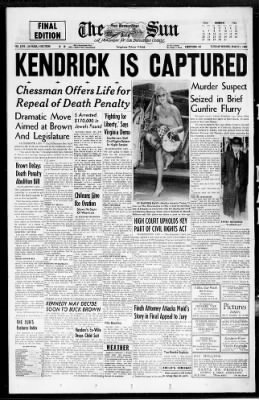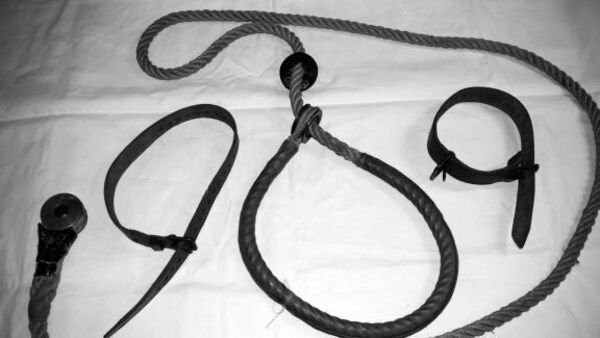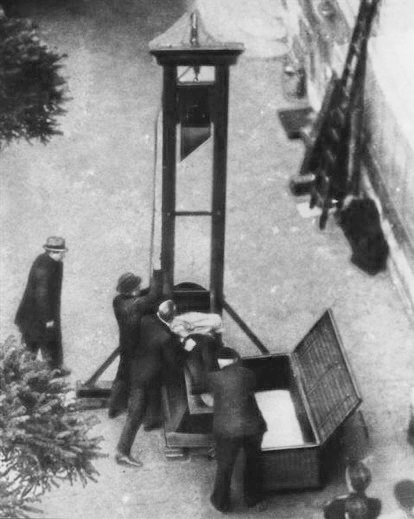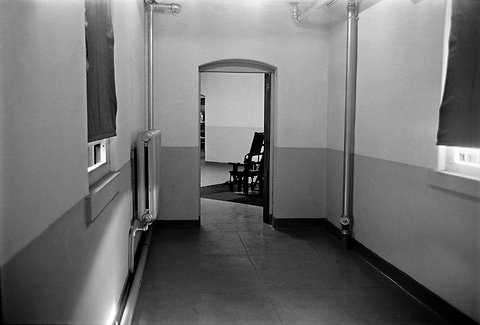As today is the sixtieth anniversary of the execution of James ‘Rabbit’ Kendrick, here’s a free chapter from my latest book ‘Murders, Mysteries and Misdemeanors in Southern California.’
The story of county music legend Merle Haggard, jailhouse lawyer and author Caryl Chessman, and professional criminal James “Rabbit” Kendrick is an unlikely tale of five convicts, two executions, and a surprising redemption. Johnny Cash never served any time but played many prison shows, including San Quentin and Folsom. Petty crook Haggard was in the audience and went on to become a legend of country music. Chessman was already a celebrity, jailhouse lawyer, and respected writer. Bunker too became a respected writer and occasional actor. Kendrick had always been a full-time felon and would never be anything else.
While at San Quentin, Haggard would talk frequently with Chessman and pal around with Kendrick. After his release, Haggard’s time in prison, especially having known Chessman and Kendrick, informed both his music and his life. Watching Johnny Cash during Cash’s legendary San Quentin show helped set him on the path to stardom, but he never forgot San Quentin, Chessman, or Kendrick; he was never able to.
Born in Oildale, California on April 6, 1937, Haggard’s beloved father died in 1945 when he was only eight years old. His father’s passing was as central a moment in his life as his time in prison and the friends he made there. Although only a boy, Haggard had a wayward nature and a strong independent spirit. Even at that age, he did what he wanted and said what he felt. Before long (and often later), that would get him into considerable trouble.
His youthful rebellion started with truancy before he was ten years old. School was not an environment he liked or especially wanted. Any hint of confinement or regulation was anathema to him. By his fourteenth birthday, Haggard’s restless nature saw him run away from Oildale. On his return, he found himself in a juvenile detention center for theft, passing bad checks, and shoplifting.
The downward spiral continued. Burglary, robbery, theft, and repeated escapes from juvenile facilities only added to his record and problems. The young Haggard’s hatred of being confined within other people’s rules only earned more of the restrictions he so hated. By his own account, he went through seventeen juvenile facilities before his eighteenth birthday, managing escapes from all of them.
By February 1958, he found himself in Bakersfield Jail for attempted burglary. His numerous prior convictions and escape-artistry saw him isolated from the other prisoners. He was locked in his cell from 4 p.m. every day and not allowed any of the activities routinely granted other prisoners. His solution was simple as Bakersfield Jail was far from escape-proof. It was the beginning of an even more serious problem.
Quickly recaptured, Haggard was returned to Bakersfield pending assignment to a more secure facility. He was astonished and, by his own admission, frightened by what the Department of Corrections had in mind. Handed the form letter in his Bakersfield cell, he saw two words that every California convict had already learned to fear—San Quentin.
He would be there anywhere between six months and fifteen years, assuming he survived. Seventeen-year-old Haggard knew San Quentin was no place for what older, hardened convicts called “fish” or “fresh meat.” All convicts were open to assault or murder at any time, discipline was hard, and death, injury, or disfigurement always possible.
Being so young, Haggard was particularly at risk of rape, perhaps repeatedly. That was nothing unusual in America’s prisons then or now. Convicts are expected to handle their own problems and settle their own scores, even when they are a teenager surrounded by some of the worst prisoners in the system. Juvenile detention had been unpleasant and Bakersfield had been tough. San Quentin would be by far the worst confinement Haggard ever experienced. It would change and scar him for the rest of his life, terrifying him his arrival on February 21. 1958. Haggard himself remarked:
“We pulled up in a bus late at night and the walls are like seventy feet high and there’s armed guards everywhere and, if you’re not scared, there’s something wrong with you. It’s a bad place to go.”
Worse was to follow. For the rest of his life, Haggard was scarred by memories of San Quentin. His own attitude and disciplinary problems did nothing to help him. Running an illegal gambling operation was a lucrative and highly dangerous decision. At a prison where a few ill-chosen words or excessive eye contact could result in death, non-payment of gambling debts was even more dangerous.
Convicts at the time often bet cigarettes by the carton or pack on football, baseball, convict handball games in the exercise yard, results of parole board meetings, or anything else to add a little excitement. Prison routine was exactly that—routine. The daily schedule seldom varied, and long-term prisoners knew the days of the week by what meals came from the prison kitchen. Just as days, weeks, months, and years blurred into each other, even the menus were usually the same.
Running his own brewery in the prison bakery lost him a prized job in San Quentin. Distributing the beer to other inmates was lucrative, and had he not been caught, it would have made life less uncomfortable. Drinking too much of his own product saw him both caught and severely punished. Haggard later described it:
“They caught me drinking some of my own beer, and I fell in the restroom, and they figured I was drunk, so they took me and locked me up in jail inside of San Quentin. And that was where I decided to change directions in my life.”
It was a bitter irony that Haggard’s over-indulgence saw him spend his twenty-first birthday in solitary. Most young Americans spend their twenty-first, the first day they can legally drink, in a bar enjoying the fact. Haggard found himself in solitary for doing what most twenty-one-year-olds take for granted. In solitary, he began to re-evaluate his path in life and decide to change it.
“Jail inside of San Quentin” meant solitary confinement in special cells on the top of North Block where the regime was even harsher than the general population, which was merely unpleasant by default. Solitary was deliberately designed to be miserable. If merely coming to San Quentin had not broken a rebellious convict, a lengthy stay in solitary was the standard punishment.
The solitary confinement cells were nicknamed “The Shelf,” and Haggard was firmly on it. The old “silent system,” where prisoners were forbidden to talk, was enforced. Any unnecessary talk (guards alone defined “necessary”) was punished. Solitary prisoners had no beds—only a thin mattress on a concrete floor. They had no books, writing materials, radios, or anything other than minimal contact with the rest of the prison. Even the food was of lower quality, and there was less of it. A convict’s first time on the Shelf could easily have them believing there could be nowhere worse in San Quentin.
San Quentin being San Quentin, it had something much worse. The internal wall separated the solitary cells from condemned row. Established on the top floor of North Block in 1937, it offered greater security than the old condemned cells nicknamed “Hangman’s Hall.” The gallows too had gone after the hanging of Raymond Lisenba (A.K.A. “Rattlesnake James”) in May 1942, California’s last hanging.
Then-Warden Clinton Duffy (a staunch opponent of capital punishment) had found the gallows destroyed a month later, choosing to overlook which convict was responsible. Since 1938, the gas chamber had been on the ground floor of North Block and had been in regular use. From the adjoining solitary cells, Haggard could discreetly break the rule on silence via an air vent. He began having deep and meaningful conversations with the condemned prisoner in the cell backing on to his own who proved a most unlikely mentor.
He was Caryl Chessman, California’s notorious “Red Light Bandit.” Convicted of kidnapping with bodily injury for the purpose of robbery, a capital crime when he was on trial, Chessman eventually found himself vilified and lionized in equal measure. Intellectuals, authors, and publishers admired him; so too did some lawyers. Warden Clinton Duffy, in charge when Chessman arrived, felt very differently. He assessed Chessman as combining the “Brains of a savant with the morals of a degenerate.”
Duffy did not stop there. To him, Chessman had “An incurably psychopathic criminal mind who most likely could never have adjusted to the society he hated so intensely. Once released Chessman would almost surely commit another crime that would land him back in prison.” The irony was that Chessman admired and praised Duffy for his reformist, rehabilitative policies. It was Chessman who smuggled a copy of an excerpt from Cell 2455 Death Row to another young prisoner who was in solitary at the time. The young Eddie Bunker was inspired, later remarking:
“I said aloud, Why not me?”
For all his many, varied, and grotesque crimes, Chessman possessed a brilliant mind. He claimed a fervent interest in penal reform and steering wayward youngsters away from the life he himself had led. Like most convicts, Chessman hated prison, especially condemned row and the very idea of capital punishment. Between his arrival in May 1948 and execution in May 1960, he wrote several insightful books, taught himself the law, and fought every effort to have him executed.
Chessman’s talks with Haggard were not without a certain dark humor—literally gallows humor in one instance. Condemned convicts received mail just like any other prisoner. It was always censored; some content (pornography for example) was considered contraband, and some simply vanished in transit, but there was still mail. Letters from the Internal Revenue Service gave Chessman a wry grin and a chuckle, but he dealt with them as anyone else would. Junk mail was a different matter. With Haggard sitting only on the other side of the wall, Chessman’s mirth suddenly rang out loud and clear. When Haggard asked him what was so funny, he was astonished to hear that Chessman had been offered a life insurance policy.
The irony was lost on neither of them. California’s gas chamber was in regular use throughout their time at San Quentin, and the atmosphere before and during executions was almost tangible. For Haggard and the rest of the prisoners, there were days of near-silence, long evenings where staff and convicts alike pondered what would happen the next day. For Chessman and the rest of condemned row, it was even worse. Whenever one or two of their number were taken away, they would walk past the other cells, saying their farewells as they went. That tension and pressure told heavily on Haggard and the other convicts. Years later, it also inspired one of his biggest hits—1967’s country classic ‘Sing Me Back Home.’
Chessman was a most unlikely mentor to a troubled, wayward young man—certainly not a mentor most people would have as their first choice—but Chessman and his struggle to survive certainly influenced Haggard. With little else to do but converse with Chessman, it is very likely Haggard influenced him in return. Haggard himself later put it: “I finally grew up in those terrible seven days. I knew that if I didn’t make some drastic changes in my life, I would wind up where Chessman was—most likely without his recognition.”
Writers are notorious for borrowing from their own lives and those of others. Chessman was no exception. We will probably never know for certain who influenced the other more, but Haggard had indeed decided to change direction. From the day he left solitary, Merle Haggard was going to go straight, leave a free man, and try making something of himself and his music. The brightest inspiration had come from the very darkest of places.
Haggard was then a convict and part-time musician. His time with Chessman had convinced him to turn his life around. The legendary Johnny Cash concert on New Year’s Day 1959 sealed the deal. Years later, Haggard, by then a peer of Cash, reminded him of it. According to Haggard, Cash remarked that he did not remember Haggard being in the band. Haggard then told him he had been in the audience.
Contrary to common myth, Cash had never been to prison, although he did endure the occasional night in the cells. In his own way, he was perhaps as troubled a man as Haggard. Many years later, Cash, aware of his own legend and Haggard’s genuine outlaw reputation, told him “Hag, you’re the guy people think I am.”
Live at San Quentin is still one of Cash’s most-appreciated albums. His concerts at the prison were certainly appreciated by the convicts, if not always their keepers. Haggard watched in awe as Cash took liberties with the guards that a convict would never get away with and the convicts loved him for it. Not only had he thought them worth playing for, but Cash had also shown his own rebellious side, as noted by Haggard:
He chewed gum, looked arrogant and flipped the bird to the guards—he did everything the prisoners wanted to do. He was a mean mother from the South who was there because he loved us. When he walked away, everyone in that place had become a Johnny Cash fan.
Haggard had certainly become a Johnny Cash fan. His conduct record needed improving and he worked hard at earning a better reputation. Joining the prison band and playing gigs for steak dinners and cigarettes sharpened his already-considerable talents. By his release in 1960, he was ready to do what James Kendrick had already told him to—make a life and career out of his obvious talent.
Further inspiration came from convict James Kendrick, and it was of the darkest kind. Known universally as “Rabbit” for his serial escapes, Kendrick also had multiple convictions. He had escaped from three prisons during his career, including San Quentin itself. Kendrick was a devoted crook, and as his criminal record lengthened, his chances of being anything else diminished—not that Kendrick cared too much.
After Haggard’s release from solitary, Kendrick approached him with both an offer and a warning. His escape-prone mind had spotted yet another opportunity, and he was determined to take it. If Kendrick could have himself sealed inside a wooden crate, then he could literally be driven out through the front gate, provided the crate was not searched or his absence noticed before the truck left the prison. That was a fairly big”if,” but still small enough for veteran escaper Rabbit to give it a try.
That was Kendrick’s offer. His warning was as clear as it was chilling. Kendrick had no intention whatsoever of surrender. If he was cornered, he would fight to the bitter end rather than return to San Quentin or any other prison. Haggard’s musical talents had already caught the eye of Kendrick and others, and Kendrick warned him against taking part. As Haggard himself later recounted, Kendrick thought he had talent. If Haggard kept a clean record, he would be free and clear in only a couple of years. Kendrick might very well be dead by then.
Haggard thought long and hard, consulting other convicts for their expert opinion on the plan, Kendrick, and the most likely outcome. They warned him not to go. With Kendrick’s record, police might shoot first and ask questions later. Kendrick’s promise not to be taken alive was not to be taken lightly. Even if the pair stayed out of further trouble (highly unlikely given their combined records), they would never really be free. They would always be hunted.
Haggard thought it over, carefully weighing up his options to stay and earn parole or flee and perhaps die. If he were caught attempting yet another escape, the system would surely throw the book at him. If he were with Kendrick and police caught them, Haggard could be killed in the crossfire. If he survived a firefight, he would very likely suffer whatever punishment the courts decided to impose on Kendrick. Whether he fought at Kendrick’s side or surrendered while Kendrick fought a last stand, Haggard would be equally liable before a judge and jury.
Haggard decided to stay, serve his time, and leave when his parole was granted. The risks of anything else were too great and the likely punishment too severe. Even Kendrick himself had warned him against going. It turned out to be the wisest, best-considered decision of the young Haggard’s life.
“Thanks, but no thanks,” Haggard told him. The younger, wilder, and more reckless Haggard might have jumped at the chance, but this time, his wilder instincts had lost. That older, wiser decision would save his life. True to the convict code, he would say nothing about the plot to anybody else. Haggard might have been beginning to reform, but he knew full well the convict code was enforced by violence. He was not the type to take advantage of the situation by becoming a prison snitch despised by convicts and guards alike.
Kendrick’s plan worked perfectly, at least as far as his second escape from San Quentin. The packing case left the prison, and Kendrick was inside it. Once out of the prison and the crate, he armed himself with a 12-gauge shotgun and stole a car. His crime spree was as short-lived as his freedom.
Robbing a supermarket near Madera turned “Rabbit” into the “Safeway Bandit.” Already wanted for the escape, Kendrick racked up another ten felony charges in the two weeks he was at large. They ended with an eleventh charge—the first-degree murder of a police officer. The Safeway Bandit had become a cop-killer; soon, he would return to San Quentin a condemned cop-killer.
Kendrick had been stopped in a stolen car near Victorville on the legendary Route 66 by California Highway Patrolman Richard Duvall. It was in the early hours of February 23, 1960, and Duvall’s last radio message had been:
“I’m chasing a fast one.”
Unfortunately for Patrolman Duvall, he caught up with him. Duvall was only twenty-six years old, husband to a pregnant wife, and had served with the C.H.P. for less than two years. Haggard had arrived at San Quentin almost exactly two years earlier.
Even though it was dark, Duvall would have readily noticed Kendrick’s shotgun if Kendrick had tried using it. Duvall did not spot the .32-caliber pistol until it was too late. By the time Duvall could have drawn his weapon, Kendrick had shot him dead and fled. Kendrick did not get far, reaching a cheap motel in San Luis Obispo before being cornered. Patrolman Duvall died on the roadside. The California Highway Patrol changed its policy after Duvall’s murder. From then on, C.H.P. officers always patrolled in pairs.
Kendrick, who had promised Haggard he would fight to the end if cornered, broke his promise. A volley of tear gas bombs left Kendrick, choking and barely able to see. While the gas swirled around the room, he heard a familiar voice—one he had been hearing since Sheriff Paul Merrick first arrested him as a juvenile offender.
Kendrick remembered Merrick, believing Merrick’s promise that he would not be harmed if he surrendered. He also believed Merrick’s threat to kill him if he resisted. Another familiar voice had led Merrick’s men to the motel. Kendrick’s wife, Diane, had tipped off local police, and Merrick wanted him incarcerated or dead. Haggard was about to have a very brief reunion with his old friend.
When Kendrick returned to San Quentin, he was taken straight to condemned row, literally a dead man walking. In fact, the condemned were easily recognized whenever they crossed the main yard. San Quentin’s convicts had a grim tradition of greeting them with chants of “Dead man coming, dead man coming.” Haggard too remembered seeing Kendrick cross the yard for his last visit to the prison chaplain, recounting the sight for Rolling Stone:
“Even though the crime was brutal and the guy was an incorrigible criminal, it’s a feeling you never forget when you see someone you know make that last walk. They bring him through the yard, and there’s a guard in front and a guard behind—that’s how you know a death prisoner. They brought Rabbit out … taking him to see the Father, … prior to his execution. That was a strong picture that was left in my mind.”
It was Kendrick’s last view of the sun and sky, neither of which he could see from Condemned Row. On November 3, 1961, he left his cell for the last time and spent his final hours in the ready room. At 10 a.m. on November 3, he was brought into the chamber, sat down, and died. Chessman was already gone.
Chessman’s brilliant mind, a legal team working for free, and public support had kept him alive through twelve years and nine appeals. By May 2, 1960, his time and appeals had run out. Neither state nor federal courts saw any merit in his writs, and even death penalty opponent Governor Edmund “Pat” Brown denied clemency. When his final legal miracle came via Federal Judge Louis Goodman, it arrived minutes too late. Chessman had already been seated and strapped when the death chamber phone rang. It was too late; the cyanide and acid had already mixed. San Quentin’s then-Chaplain Byron Eshelman takes up the story:
“Warden Dickson nodded for the pellets to be dropped. They were. Chessman seemed to flinch every time he took a breath. There was a whispering and commotion over where the Warden stood. Later I heard this was the business of the phone message from Federal Judge Goodman who was trying to stop the execution for thirty minutes to give Chessman’s attorneys time to make their appeal.”
That call was said to have been delayed by Goodman’s secretary dialing the wrong number. By the time she dialed the right one and had been connected, Chessman was already dying. Warden Dickson was heavily criticized afterward for having let the execution continue. Some said he could have activated the chamber’s extractor fan, and officers wearing gas masks could have entered, cut the restraining straps, and saved Chessman.
That was debatable at best. It would likely have seen Dickson criticized equally for endangering the witnesses and execution team and made no difference to anybody especially Chessman. He still took nearly fifteen minutes to die. Chessman and reporter Will Stevens had agreed beforehand that if his suffering was intolerable, Chessman would signal Stevens. Minutes after the gas was released, Chessman slowly nodded his head.
Without Chessman, Kendrick, and Cash, Haggard might have remained an unknown petty crook drifting between prisons, doing what some convicts call “life on the installment plan.” Haggard could have found himself serving six months here, two years there, and five somewhere else, only out long enough to re-offend and return to prison. That was assuming Haggard survived attacks from other convicts, shootouts with lawmen, and avoided committing any capital crimes. Chessman and Kendrick both had and paid with their lives.
Haggard was never more than a petty criminal, certainly nowhere near the level of Chessman or Kendrick. Unlike Haggard, they were professionals who risked life and limb, stealing and hurting others for a living while Haggard’s crimes were comparatively minor. Drunkenness, check fraud, and petty theft were his mainstays with only the occasional barroom brawl. Chessman and Kendrick preferred armed robbery, burglary, and—in Kendrick’s case—repeated escapes.
Haggard’s more minor crimes saw him cycle through juvenile institutions, Bakersfield jail, and finally San Quentin. He avoided sharing the fate of Chessman, Kendrick, and so many others, going on to become a superstar. His venues would be real ones before his many fans, not a perforated steel chair in San Quentin’s “little green room” with his audience watching him die.





Leave a Reply